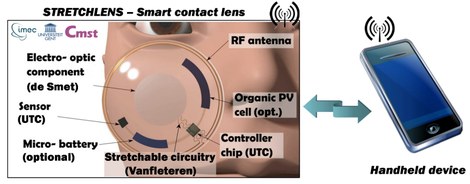Marie Skłodowska-Curie Action IF STRECHLENS
“STRECHLENS-Deformable platform with thin-film based circuits and ultra-thin Si chips for smart contact lens applications”
The STRETCHLENS project includes inter/multidisciplinary activities that encompass the modelling, design and realization of electrically-interconnected multilayer stretchable systems, including UTC’s and LC cells towards smart contact lens applications.
Number of partners: Host Institute: imec (Belgium) and Ghent University (Belgium)
Details of coordinator: prof. Jan Vanfleteren, jan.vanfleteren@ugent.be, Centre for Microsystems Technology (CMST), Ghent University, affiliated with imec
Duration: 24 months, starting on September 2016
The project

For the first two application areas, possible approaches have already been demonstrated. However, the use of smart contact lenses to correct vision has only been recently proposed through the help of integrated liquid crystal (LC) cells. The integration of these LC cells in a contact lens is in particular appealing for ophthalmological disorders like iris perforation and presbyopia; the latter alone affecting more than 1 billion people.
The STRETCHLENS platform envisages the hybrid integration of electro-optic capabilities (e.g. LC cells), RF transmission (e.g. antenna, ultra-thin Si chip - UTC), specific biomarker sensing (e.g. to identify some types of cancer cells) and thin-film based stretchable electrical interconnections. The platform, besides being stretchable due to the spherical shape of eye and manipulations during insertion/extraction of the lens, will incorporate novel 3-D electrical interconnections which will allow for multilayer metallization to integrate UTC’s, minimizing surface area and greatly improving miniaturization.
Furthermore, the project will develop new knowledge through technological advancement and models of adhesion/cohesion at the interface of hard/soft composites, in order to predict delamination failures and optimize assemblies through design. The completion and development of such highly integrated stretchable systems will open up diverse research opportunities in the fields of biomaterial science, stretchable micromechanics, and autonomous biomedical and conformal electronics smart systems.
Objectives
These are the objectives of STRECHLENS:
• Realize fully stretchable and bio-fitted platform with integrated liquid crystal (LC) cells.
• Integrate within such platforms ultra-thin silicon chips (UTC’s) for the correct functioning.
• Design and fabricate thin-film based stretchable electronics to link the LC cells and UTC chips.
Role of Ghent University
Contact
Dr. Andrés Vásquez Quintero
Electronica en Informatiesystemen
Centre for Microsystems Technology
Ghent University
Affiliated with IMEC vzw
tel : +32-9-264.66.24
Andres.Vasquez@UGent.be
Prof. Jan Vanfleteren
Electronica en Informatiesystemen
Centre for Microsystems Technology
Ghent University
Affiliated with IMEC vzw
tel : +32-9-264.53.60
Jan.Vanfleteren@UGent.be
